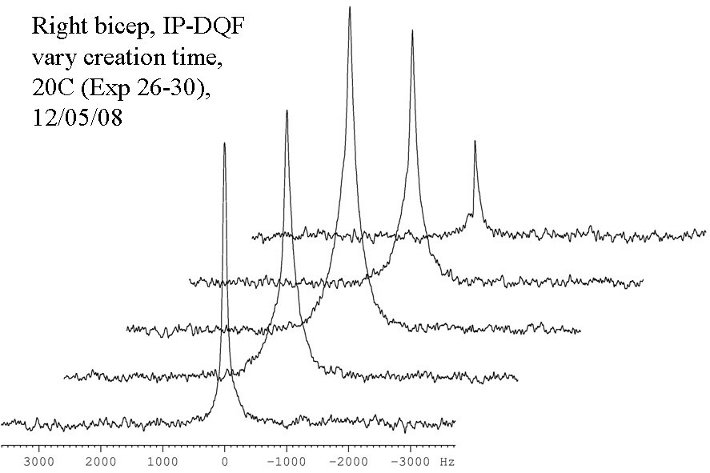DQF-NMR
Tendons serve a primarily mechanical role; consequently, the mechanical properties of tendons are important to their function. The primary load-bearing structure in tendon is collagen, and the organization of the collagen network is known to affect the tendon's mechanical properties. Following injury, the collagen network becomes disorganized, but as the tendon heals over time, the organization of the collagen network improves. Thus, for injured tendon, the level of collagen organization indicates how well the tendon has healed, and therefore, a measure of collagen organization could be used to judge when a tendon has healed enough so that normal activity can be resumed following tendon injury. Unfortunately current methods for measuring tendon organization, such as polarized light analysis, are destructive. There is therefore a need to develop non-destructive and, preferably, non-invasive measures of collagen organization.
 Our collaborator, Gil Navon, has developed a novel NMR (nuclear-magnetic-resonance) technique, capable of detecting 'organized' water that is loosely bound to collagen. He has used this technique (double quantum filtering - DQF) to study tendon following detachment, in a rabbit Achilles model (Ikoma et al., 2003). Our collaborative project, funded by the NIH/NIAMS, attempts to employ the DQF-NMR technique in our rat rotator cuff model.
Our collaborator, Gil Navon, has developed a novel NMR (nuclear-magnetic-resonance) technique, capable of detecting 'organized' water that is loosely bound to collagen. He has used this technique (double quantum filtering - DQF) to study tendon following detachment, in a rabbit Achilles model (Ikoma et al., 2003). Our collaborative project, funded by the NIH/NIAMS, attempts to employ the DQF-NMR technique in our rat rotator cuff model.
To date, we have successfully acquire DQF-NMR spectra from isolated rat biceps (long head) tendon and shown the creation time dependence of the DQF spectra. Currently we are working on 2D-spectroscopy to evaluate the change in organization along the length of the tendon from mid-substance to the bony insertion, which we have previously shown to become less organized (Thomopoulos et al., 2003).
For more information see:
- Ikoma K, Kusaka Y, Takamiya H, Eliav U, Navon G, Seo Y. Evaluation of collagen fiber maturation and ordering in regenerating tendons employing H-1 double quantum filtered NMR spectroscopy. J Orthop Res 21:149-156, 2003.
- Thomopoulos S, Williams GR, Gimbel JA, Favata M, Soslowsky LJ. Variation of biomechanical, structural, and compositional properties along the tendon to bone insertion site. J Orthop Res 21:413-419, 2003.
